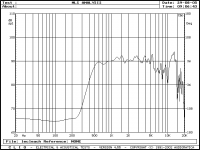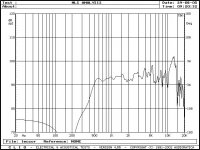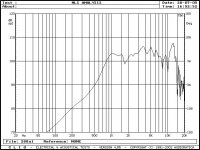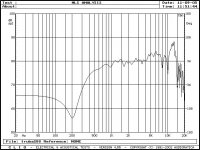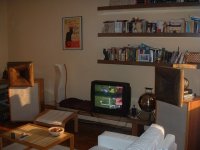Hi,
i am using an active 2-way system.
I use a Onken bass with a parasound transistor amp.
For the high frequ. >800 Hz i am using a 45 single ended tube amp (2-stages Bugle Amp)with a 288-16K Altec driver.
The problem is, that the 288- Altec driver begin rolling off at ~7 kHz.
Is there any possibility to compensate this behaviour with the 45 SET amp?
Greetings Barossi

i am using an active 2-way system.
I use a Onken bass with a parasound transistor amp.
For the high frequ. >800 Hz i am using a 45 single ended tube amp (2-stages Bugle Amp)with a 288-16K Altec driver.
The problem is, that the 288- Altec driver begin rolling off at ~7 kHz.
Is there any possibility to compensate this behaviour with the 45 SET amp?
Greetings Barossi
Wild guess
Of course. You need to insert a step network at the input of your SET amplifier. The problem is that you need to know reasonably accurately what the response of your HF driver is like. Still, I'll take a wild guess and assume that it's about 4dB down. We make a 4dB attenuator out of a 360k resistor and a 620k resistor. The 620k resistor replaces your existing grid leak resistor. Next we put a capacitor across the 360k resistor to short circuit it at HF so that although you have 4dB of attenuation at LF, you have none at HF. Try a 68pF capacitor. If that gives too much effect, reduce it, if too little, increase it.
Of course. You need to insert a step network at the input of your SET amplifier. The problem is that you need to know reasonably accurately what the response of your HF driver is like. Still, I'll take a wild guess and assume that it's about 4dB down. We make a 4dB attenuator out of a 360k resistor and a 620k resistor. The 620k resistor replaces your existing grid leak resistor. Next we put a capacitor across the 360k resistor to short circuit it at HF so that although you have 4dB of attenuation at LF, you have none at HF. Try a 68pF capacitor. If that gives too much effect, reduce it, if too little, increase it.
> the 288- Altec driver begin rolling off at ~7 kHz.
It's been decades since I stood in front of a 288. But the driver starts falling at 2KHz-3KHz. The Old Men knew this, and designed the horns to compensate. That's easy in theater use (and I don't think you should use 288 in any room smaller or liver than a theater): make the horn less directional below 2KHz and more directional above 4KHz. The sweet thing is: that's what an exponential horn does anyway! The tough part is getting a proper match between driver droop and horn on-axis rise, while still hitting all the paying customers.
Oh, and in a small room, the wide dispersion at 500Hz and the tight beaming at 15KHz mean a very odd off-axis and reverberation sound.
Oh, and any practical horn will have many cross-modes causing dips and lumps in the response. That 13KHz peak may be a throat cross-mode, and will almost certainly move or vanish if you move the microphone a foot left or right, up or down.
About 1975, fashion changed to Constant Directivity horns. These have the same pattern 1KHz to 10KHz. When used with a max-efficiency driver (288 is close enough) they drop above 2KHz, but the same all over the room, and a simple R-C network like EC8010's will get back to pretty-flat everywhere. And since the efficiency of the 288 is SO high, you can (as Vuki says) equalize between power amp and driver: put 50 ohms in series with the 288, bypass the 50 ohms with about 1uFd. That works for Constant Directivity horns; it won't be right for classic Exponential or Sectoral horns such as you seem to have. Vuki's plot does slump less, but the peak-dip will be more annoying than before.
Personally, I think you need to change the horn. No, I don't have a suggestion: I made my own out of lumber and fiberglass until Altec, JBL and EV got their CD horns into production. And the commercial CD horns are mostly not very CD or much too big for the home (my JBLs are 4 feet long, some MantaRays were longer).
Here is another trick. Take the horn off. Use the driver without a horn. With the 1" or 2" opening, dispersion will be VERY wide and uniform up to the top of the audio band. In a home, this is a better sound than a big honky-horn. The drawback is lower efficiency and a VERY low power handling at 500Hz. However I have used JBL 2440 this way in a home, at high listening level. Yet another technique, for some drivers, is to take the back cover off and listen to the diaphragm. A 2440 is a killer 4" direct radiator. I only tried that once because my 2440s are the rare Beryllium model, and that stuff is toxic. Every other driver ever made is aluminum or phenolic, quite safe to health. Of course children and cats are dangrous to diaphragms.
It's been decades since I stood in front of a 288. But the driver starts falling at 2KHz-3KHz. The Old Men knew this, and designed the horns to compensate. That's easy in theater use (and I don't think you should use 288 in any room smaller or liver than a theater): make the horn less directional below 2KHz and more directional above 4KHz. The sweet thing is: that's what an exponential horn does anyway! The tough part is getting a proper match between driver droop and horn on-axis rise, while still hitting all the paying customers.
Oh, and in a small room, the wide dispersion at 500Hz and the tight beaming at 15KHz mean a very odd off-axis and reverberation sound.
Oh, and any practical horn will have many cross-modes causing dips and lumps in the response. That 13KHz peak may be a throat cross-mode, and will almost certainly move or vanish if you move the microphone a foot left or right, up or down.
About 1975, fashion changed to Constant Directivity horns. These have the same pattern 1KHz to 10KHz. When used with a max-efficiency driver (288 is close enough) they drop above 2KHz, but the same all over the room, and a simple R-C network like EC8010's will get back to pretty-flat everywhere. And since the efficiency of the 288 is SO high, you can (as Vuki says) equalize between power amp and driver: put 50 ohms in series with the 288, bypass the 50 ohms with about 1uFd. That works for Constant Directivity horns; it won't be right for classic Exponential or Sectoral horns such as you seem to have. Vuki's plot does slump less, but the peak-dip will be more annoying than before.
Personally, I think you need to change the horn. No, I don't have a suggestion: I made my own out of lumber and fiberglass until Altec, JBL and EV got their CD horns into production. And the commercial CD horns are mostly not very CD or much too big for the home (my JBLs are 4 feet long, some MantaRays were longer).
Here is another trick. Take the horn off. Use the driver without a horn. With the 1" or 2" opening, dispersion will be VERY wide and uniform up to the top of the audio band. In a home, this is a better sound than a big honky-horn. The drawback is lower efficiency and a VERY low power handling at 500Hz. However I have used JBL 2440 this way in a home, at high listening level. Yet another technique, for some drivers, is to take the back cover off and listen to the diaphragm. A 2440 is a killer 4" direct radiator. I only tried that once because my 2440s are the rare Beryllium model, and that stuff is toxic. Every other driver ever made is aluminum or phenolic, quite safe to health. Of course children and cats are dangrous to diaphragms.
- Status
- This old topic is closed. If you want to reopen this topic, contact a moderator using the "Report Post" button.
- Home
- Amplifiers
- Tubes / Valves
- Active compensation...
